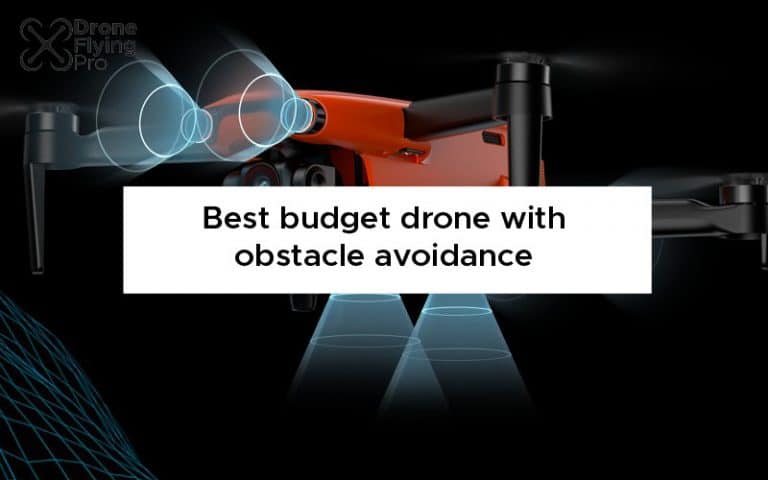Finding a drone with obstacle avoidance is very important. Luckily many budget drones can offer obstacle avoidance. You do not have to break the bank to ensure that your drone is safe in the trickiest and tightest of flying environments. Whether you are flying in overhanging branches or you need to weave in and out of a complicated scene – obstacle avoidance is your friend.
The best budget drones with obstacle avoidance include the DJI Mavic Air, the Autel EVO Nano and Lite. These drones have three-way sensing to ensure that you have the safest flight possible.
Obstacle avoidance is a safety feature found in modern drones. It enables the drones to continuously scan and monitor the environment and detect any obstacle in their way. Once the drone detects the obstacle, it can stop flying toward it, and some will also be able to fly around the obstacle to continue its path home. Manoeuvring around an obstacle is particularly useful for drones with the return to home feature.
I’ve had to turn off the obstacle avoidance only a couple of times to squeeze my drone through tight branches and areas to capture the perfect shot. With the obstacle avoidance active, the drone would not get close to the gap in the trees for me to fly through.
How does obstacle avoidance work?
Obstacle avoidance utilises multiple advanced techniques and functions in drones. It can use sensors and mapping features to work out its localised environment. The GPS module works with the obstacle avoidance system to ensure a safe and stable flight, allowing millimetre precision to navigate complex 3D environments.
Many smaller drones (such as the DJI Mavic Mini 2) do not offer obstacle avoidance because of the small form factor and the amount of space required to squeeze in all sensing equipment.
The sensing equipment also adds a lot of weight to the drone, and the manufacturers would struggle to get it under the 250 g weight limit.
In some countries, drones less than 250 g do not need a pilot license or be registered. This legislation makes the 250 g weight limit an attractive target for sales.
Typically, a drone obstacle avoidance system uses vision sensors, infrared sensors, and auxiliary light to stay in the air safely.
Here is an example of the sort of data that is streaming into a drone as it is flying.
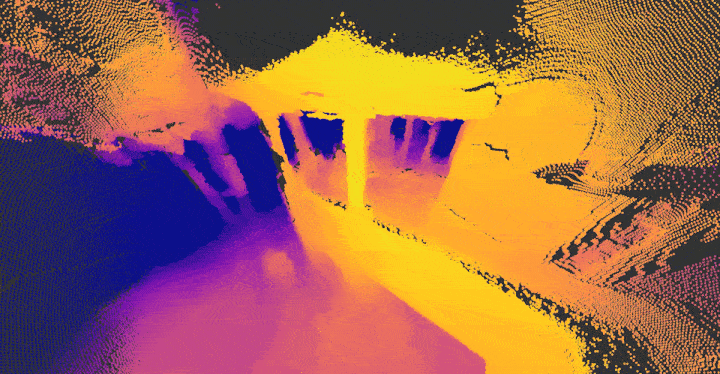
Vision sensor
A vision sensor is typically accurate up to 25 m. Stereoscopic sensors combine images from two cameras and infer how far something is from the camera. It’s very similar to how our eyes work and how we can perceive depth. Using and analysing the images from two spaced cameras can also deduce a 3D shape.
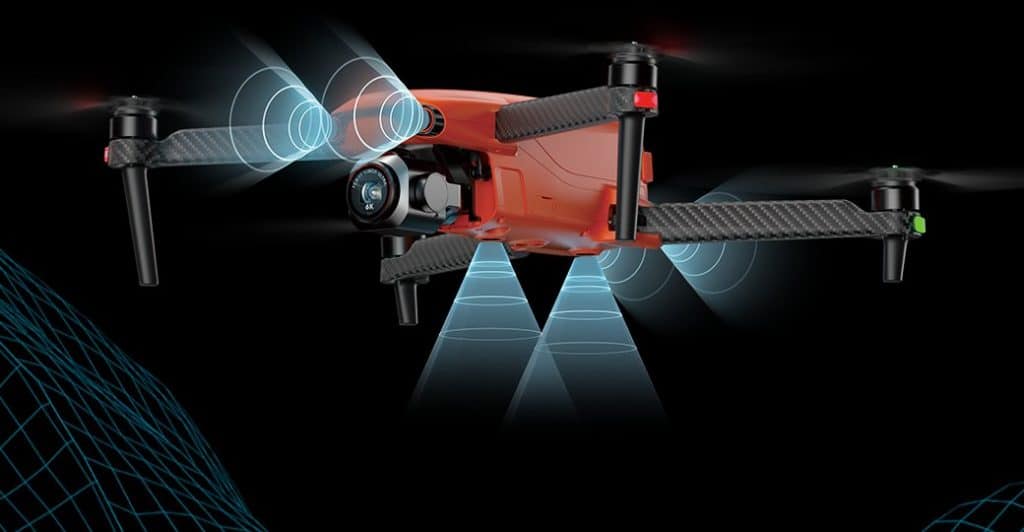
Infrared sensor
An infrared sensor uses infrared radiation to map the surroundings. Like your remote control for your television, the infrared beam can be reflected off a surface and collected in the sensor. Many drones use this downwards to estimate how far away from the ground they are flying.
It helps a lot with precision landings
Other technology
Different drone manufacturers use different types of technology to determine the distances of things from the drone.
- Some drones use a dedicated camera to construct a 3D model of its surroundings using stereoscopic techniques.
- Memory – some drones remember their surroundings in the environment to navigate more quickly if they return to the same environment.
- Auxiliary assist light – the auxiliary light will turn on and off to help the drone use stereoscopic cameras to measure the distance to the ground. Perfect for low light conditions.
- 4K camera mapping – some more advanced drones (such as Skydio) utilise six 4K cameras to build a 3D map of their surroundings. They also utilise deep learning algorithms and advanced AI to predict the movements of the surroundings relative to the drones flight.
- 360° obstacle avoidance – many advanced drones now utilise 360° cameras and sensors for creating a safety bubble around the drone during flight.
As drone technology improves, we can expect lower-end budget drones also utilise 360° obstacle avoidance and advanced artificial intelligence algorithms. However, where size is a priority for drones, we will see them utilise as few obstacle avoidance sensors as possible.
Here are the best budget drones with obstacle avoidance currently on the market.
The best cheap drones with obstacle avoidance
| Drone | Price | Obstacle avoidance system |
|---|---|---|
| EVO Nano | $949.00 | Three-way binocular vision sensors enable the drone to perceive obstructions in front of it, behind it, and below it. |
| Mavic Air | $619.00 | Three-way binocular vision sensors enable the drone to perceive obstructions in front of it, behind it, and below it. Precision landing with downward-facing cameras. |
| EVO lite | $1,549.00 | Three-way binocular vision sensors enable the drone to perceive obstructions in front of it, behind it, and below it. The sensors give the EVO Lite a front field of view of 150 degrees, eliminating more blindspots than traditional systems while reducing the number of cameras needed. |
| Hilldow Camera Drone | $69.99 | 260 degree Infrared Obstacle Avoidance |
Hilldow Camera Drone – Cheapest Drone
This squad has a 270° infrared detection for obstacles. It allows you to fly securely with altitude hold and emergency stop features.
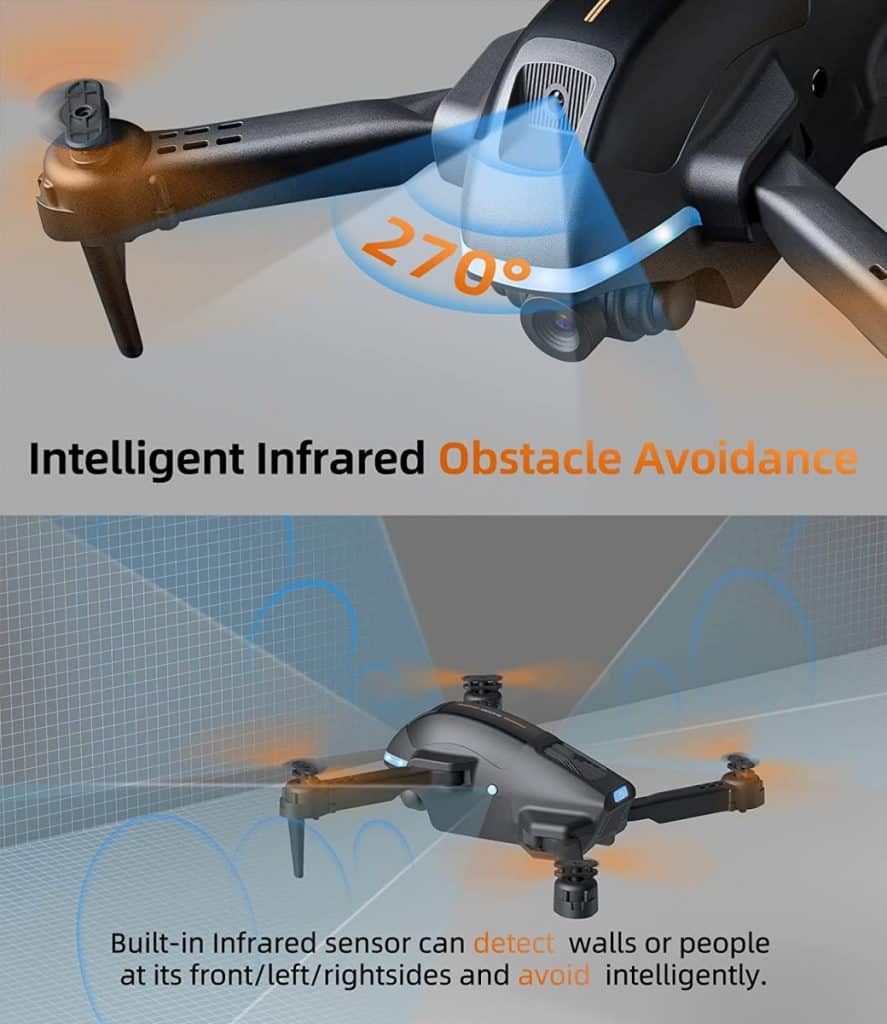
Being such a cheap camera it only has a flight time of seven minutes per battery but comes with multiple batteries. This is perfect for a child or beginner who is looking to get into the drone flying space.
Specifications
- Quadcopter Weight: 104 g / 3.67 oz (without protection frames)
- Dimension: 5.2 x 3.2 x 1.6 inch (Folding Size) / 7.7 x 6.6 x 1.6 inch (Unfolding Size)
- Max Flight Time: 7 minutes per battery (depends on the speed)
- Charging Time: about 120 mins per battery
- Max Flight Distance & Altitude: 262 feet/ 80 m (depends on phone device and environment)
- Max FPV Transmission Range: 82 feet/ 25 m (depends on phone device and environment)
- Camera Adjustable Angle: 0° – 90° manually
Autel Evo Nano – Best small drone
This drone is an ultralight companion for photographers, travellers, and hobbyists. DJI has owned the small drone space for a long time. With this drone, Autel has brought the competition.
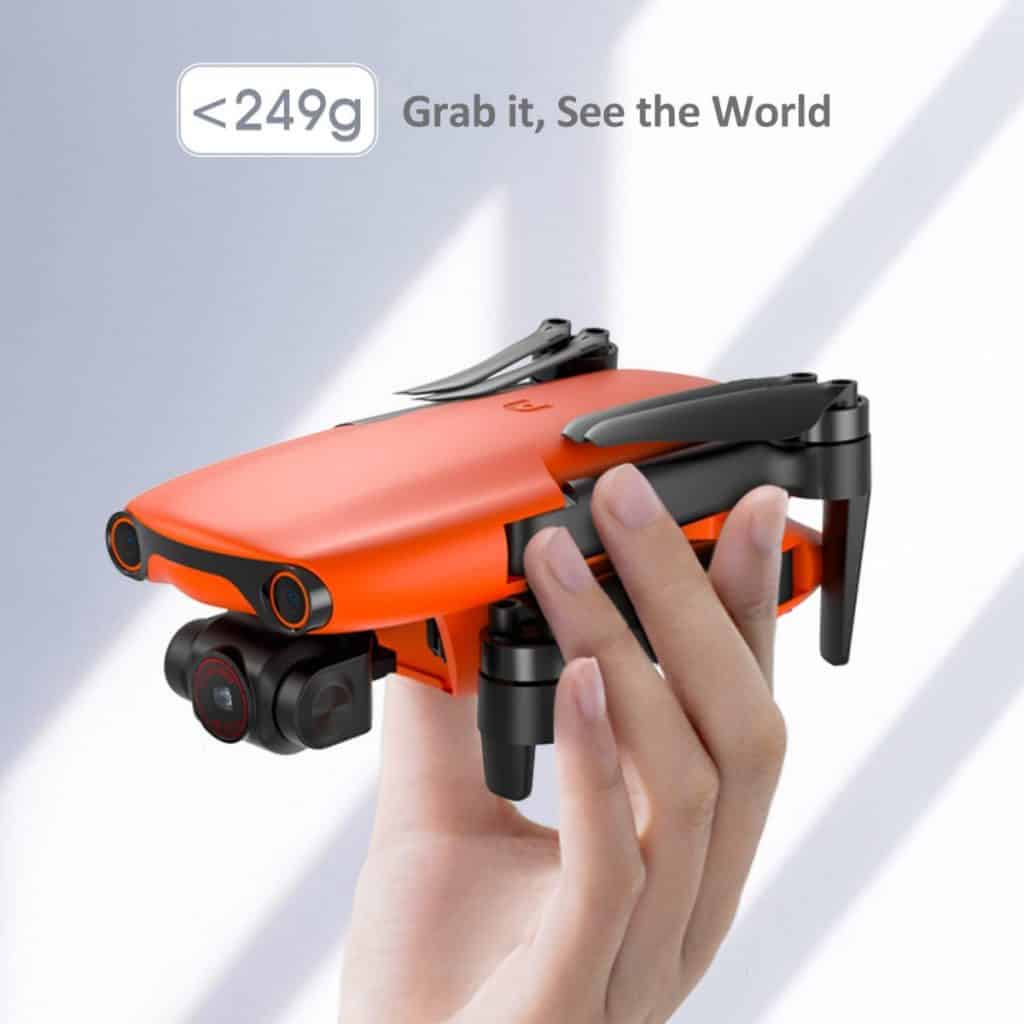
On the camera side, this packs a huge punch. This drone is packed with a 1/1.28-inch(0.8-inch) CMOS sensor capable of 50 MP photos. It offers incredible noise reduction capabilities and can work very well in low light conditions.
With all of the dynamic tracking that people have come to expect from drones, this can focus on any person, animal, or vehicle, so you can focus on flying your drone while the camera is always pointed at the subject.
I love this company because they have squeezed an advanced obstacle avoidance system into a very small drone. It has a three-way binocular vision sensor that enables the drone to perceive distances in front, behind, and below. It can easily detect obstacles using this stereo binocular system and will stop the drone before it hits anything.
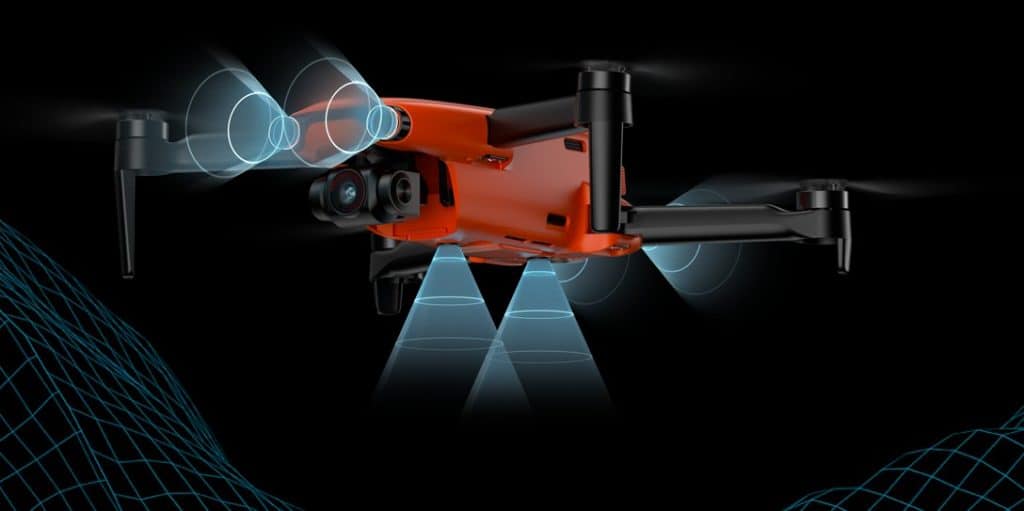
With a massive 28 minute flight time, there has never been a better time to experiment with creative angles and dream up inventive shots. Long gone are the days when you have to rush through your shot list – now, you can capture everything you want with a single battery.
DJI Mavic Air – Best Old Drone
If you are looking for a budget drone with obstacle avoidance, I recommend looking at an older drone. One of the best drones that you can pick up for very little money is the DJI Mavic Air. The DJI Mavic air was my first drone, and I love it for various reasons. In my opinion, it could still be the best drone that DJI has ever produced.
Not only is the DJI Mavic air small and portable, but it also carries an impressive camera and range of features. It was the perfect stop-gap between the mini and the pro.
Here is what I think of the DJI Mavic air:
The Mavic Air weighs 430 g and carries a 12-megapixel camera. It has 4K ultra high definition video resolution and can record in MP4 and MOV formats. The sensing system can measure between 0.5 and 12 m with a field of view of approximately 50°. More than enough to protect your drone while flying in standard conditions.
The DJI Mavic air only has forward-facing, downwards facing, and rear obstacle avoidance. Sometimes I have had to abort my plans to do a sideways planning shot because of the chance of running into a branch while moving sideways.
The one thing I absolutely love about the DJI Mavic air is how it packs down into a very small and portable case.
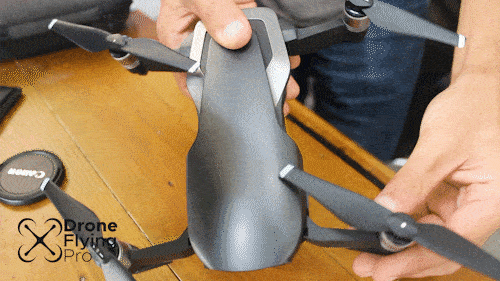
If you decide to buy this drone, I recommend purchasing an extra two batteries. The extra batteries are becoming harder and harder to source as this drone is discontinued. With extra batteries and some extra propellers, there is no doubt that this will be a powerhouse drone for you with awesome obstacle avoidance.
Autel Evo Lite Series
The Lite series of drones are a fantastic way of getting an affordable drone with obstacle avoidance.
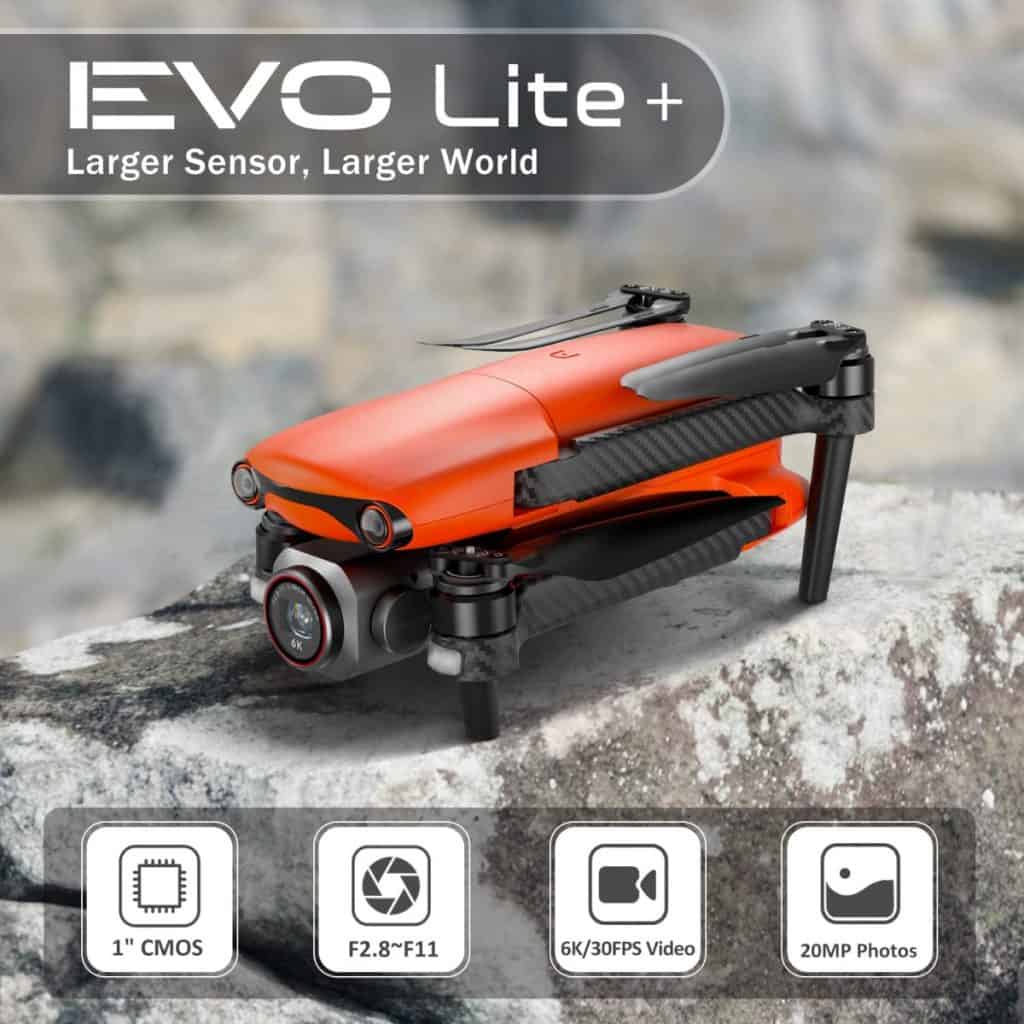
The Evo lite features a 1 inch CMOS image sensor and powerful moonlight algorithms, allowing you to capture great footage even in low-light situations. It can capture 30 frames per second and has a 6K resolution.
You can track fast-moving subjects with excellent autofocus that locks in within milliseconds. It has automatic flight modes, including rocket, fade away, and orbit, so you can shoot stunning footage quickly.
The drone also has ultra-wide-angle object avoidance, ensuring that your drone is as safe as possible when flying. The obstacle avoidance sensors provide a 150° view of potential obstacles eliminating blind spots found in other drones while reducing the number of cameras needed. The reduction in cameras reduces the cost of the drone whilst also balancing its ability to protect itself.
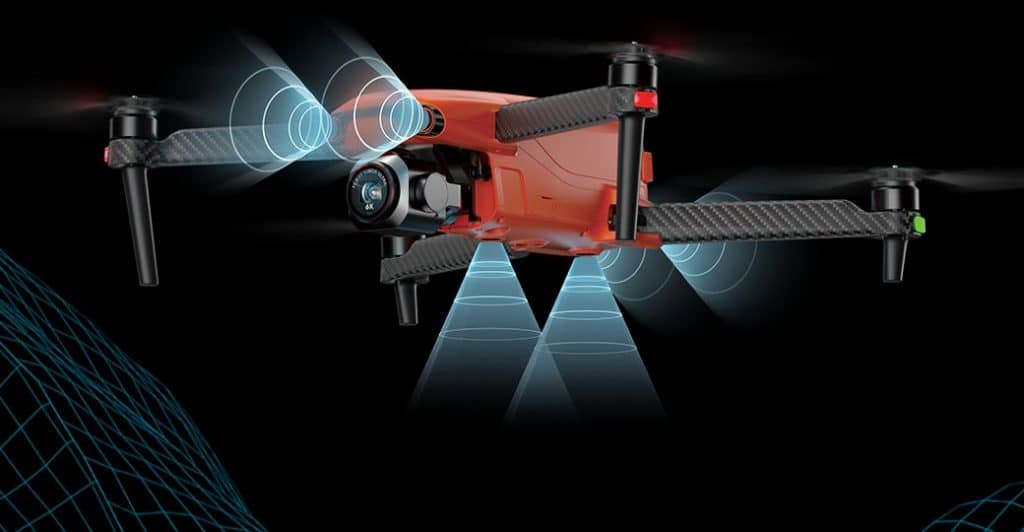
It is a fantastic series of drones that you should seriously consider purchasing if you are serious about excellent photography and obstacle avoidance.
Benefits of obstacle avoidance
There are many benefits of purchasing a drone with obstacle avoidance. I know that the obstacle avoidance system on my drone has saved me several times from a near-catastrophic accident. Even the thinnest branches can bring down your drone, and an obstacle avoidance system will help you avoid them.
Safety
Safety is the number one reason you should consider getting a drone with obstacle avoidance. Obstacle avoidance will allow you to fly in complex 3D environments with more confidence and safety than without it.
A couple of times, I have been flying my drone near trees, and I haven’t seen a branch coming near the rear of the drone. People get so fixated on the screen and the first-person video view that it can be surprising when your drone warns you of something nearby.
Many advanced auto shots
A drone with obstacle avoidance comes with many advanced automatic shots. These automatic shots perform very cinematic and smooth manoeuvres whilst capturing the subject or landscape. The advanced automatic shots can include follow me mode, active track, rocket, orbit, and many other shots.
Sending the drone off into the sky with a button click can be very nerve-racking. However, with obstacle avoidance, the drone is sure to return safely and stop or easily navigate around different obstacles.
Peace of mind
I was very protective of my drone for the first few flights. I certainly got too close to some overhanging obstacles, and the positioning system warned me. This piece of mind was perfect for me as a beginner pilot.
The more you spend on the drone, the greater peace of mind you are purchasing. Spending a little bit more on a drone with obstacle avoidance will certainly help you feel much better while piloting in the early days or in a situation you are unfamiliar with.
Indoor flight
Flying indoors is a tricky task as the GPS generally doesn’t work either, and the drone has to rely on the visual positioning system. Relying on the visual positioning system alone is not always the best in budget drones, and obstacle avoidance will give the extra layer of security for flying near walls, furniture, and people.
Who are budget drones with obstacle avoidance for?
Purchasing a budget drone with obstacle avoidance means accepting that some of the hardware is not as powerful as the top of the range drones on the market. However, with the reduced price often comes a smaller form factor and more confidence when flying your drone.
Budget drones with obstacle avoidance are perfect for beginner pilots, photographers, and travellers.
Beginner pilots
More and more modern drones now come with obstacle avoidance, so it is easier than ever to afford a beginner drone that will help you fly with confidence.
Beginner pilots will benefit from having obstacle avoidance. It will increase the pilot’s confidence and allow them to focus on other aspects of the flight, such as navigation and photography or videography.
Photographers
When I fly my drone, I am often so obsessed with framing the photo or video that I sometimes neglect the very basic aspects of flying my drone.
Having an obstacle avoidance system means that I can confidently engross myself in the creative parts of drone flying without worrying about the drone accidentally clipping overhanging branches or other aerial obstacles.
If you are serious about photography, I highly recommend that you purchase a drone with a robust level of obstacle avoidance.
Travellers
If you are buying a drone for travelling, it is highly recommended that you buy one with a good level of obstacle avoidance. Travelling with a drone often means flying in unfamiliar areas and new territory. The pace of travelling often means that you don’t want to sit around for ages, getting the best shot and navigating the terrain.
An obstacle avoidance system will help you fly confidently no matter where you end up.
Buyers’ guide for obstacle avoidance drones
When you are looking to buy a budget drone with obstacle avoidance, there are a few things that you should locate full see you don’t end up with buyer’s remorse. The range of sensors on the drone, the type of obstacle avoidance it has, and whether or not you can turn it off are important parts of learning to fly a drone and choosing the best drone for you.
Range of sensors
The first thing I would look for is how much protection the obstacle avoidance sensors give me. At the minimum, I would expect my drone to have forward, backward, and downward-facing obstacle avoidance sensors. This amount of protection is now standard in mid-range drones.
Type of obstacle avoidance
Obstacle avoidance is also an interesting decision point for this type of drone. Obstacle avoidance often comes in two forms.
- The first involves the drone simply stopping and refusing to move once an obstacle is detected.
- The second type of obstacle avoidance is where you can continue to move the drone towards the obstacle and it will find its way around the obstruction.
More and more drones are becoming advanced and capable of manoeuvring around complex obstacles. At the very least, your drone should be able to warn you with an audible or visual warning system and come to a complete stop away from the obstacle.
Can you turn it off?
Lastly, I would look for a drone where you can easily turn the obstacle avoidance system off while flying. I have had to turn the obstacle avoidance system of wants to enable me to fly between two branches that are close together. I wanted to capture a flight where I flew through some tree branches and then up to grab a shot of the city skyline.
Being able to turn off the obstacle avoidance when it is detrimental to the shop that you want to take is an important thing to be able to do. Make sure that you can turn it off easily through the software while flying.
The final word
This article has been through everything you need to know about buying the best budget drone with obstacle avoidance. Obstacle avoidance is an important feature for beginner pilots, travellers, photographers, and anyone who wants to protect their drone while flying.
If your budget does not stretch to the dearest of drones, you can purchase older models with the obstacle avoidance feature to get a drone within your budget.
Obstacle avoidance is becoming a standard feature in mid-range drones, and I reckon we will see the function incorporated into budget drones shortly.
